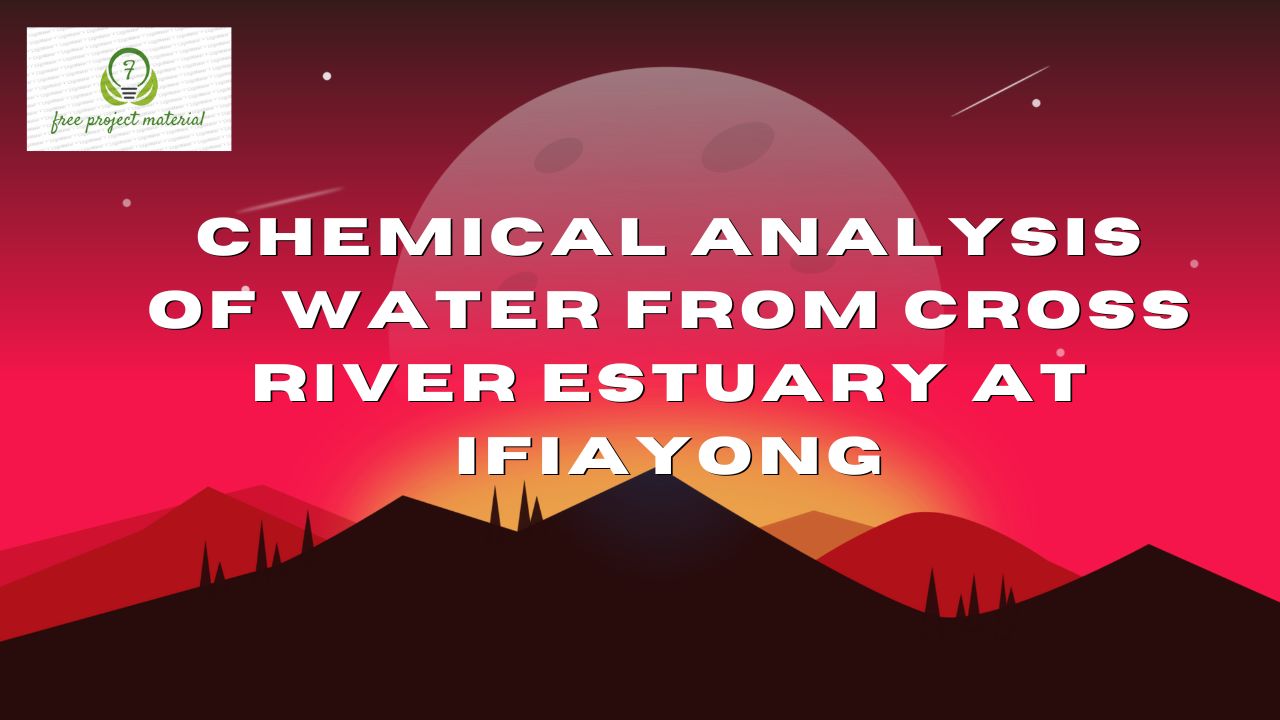ABSTRACT
Water is very important to living organism due to its enormous uses, but the alteration of the chemical parameters due to anthropogenic and natural activities pose a threat to plant and animal. In this regard, this study was carried out to investigate the chemical composition of Cross River Estuary Ifiayong. The analysis were carried out using standard analytical procedures. The result of the analysis revealed the following: Acidity 192.00±0.020mg/l, Alkalinity 56.00±0.003mg/l, Total Hardness (TH) 42.00±0.012mg/l, Dissolved oxygen (DO) 13.35±0.015mg/l, Biochemical Oxygen Demand (BOD) 6.70±0.004mg/l and Chemical Oxygen Demand (COD) 31.12±0.003mg/l. this result suggest that the water is suitable for domestic and industrial uses.
TABLE OF CONTENTS
TITLE PAGE – – – – – – – i
CERTIFICATION – – – – – – ii
DEDICATION – – – – – – – iii
ACKNOWLEDGEMENT – – – – – iv
ABSTRACT – – – – – – – v
TABLE OF CONTENTS – – – – vi-ix
CHAPTER ONE
INTRODUCTION – – – – – – 1
1.1 Background of the Study – – – – – 1-3
1.2 Aim and Objectives of the Study – – – – 3
1.2.1 Aim of the Study – – – – – – – 3
1.2.2 Objectives of the Study – – – – – – 3
1.3 Significance of the Study – – – – – 4
1.4 Scope and Limitation of the Study – – – – 4
1.4.1 Scope of the Study – – – – – – 4
1.4.2 Limitation of the Study – – – – – – 4-5
CHAPTER TWO
2.0 LITERATURE REVIEW – – – – – 6-9
2.1 Overview of Analysis of Water Chemistry – – 9-10
2.2 Methodologies Employed in the Analysis of
Water Chemistry — – – – – 11-13
2.3 Description of Estuary – – — – – 13-15
2.4 Classification Base on Geomorphology – – – 15
2.4.1 Drown River Valley – – — – – 15-16
2.4.2 Lagoon-Type of Bar-Built – – – – 16-17
2.4.3 Fjord-Type – – – – – — – 18-19
2.4.4 Tectonically Produced – – – – – – 19
2.5 Classification Based on Water Circulation – – – 19
2.5.1 Salt Wedge – – – – – – – 19-20
2.5.2 Partially Mixed – – – – – – – 20
2.5.3 Inverse – – – – – – – 20-21
2.5.4 Intermittent – – – – – – – – 21
2.6 Chemical Variation in Estuary – – – – 21-22
2.7 Implication of Physiological Variation – – – 22-23
2.7.1 Human Impact on Estuary – – – – – 24
2.8 Previous Studies on Chemical Composition of Estuaries – 24-26
CHAPTER THREE
3.0 MATERIALS AND METHODS
3.1 Materials and Reagents – – – – – – 27
3.2 Sample Collection and Preparation – – – – 27
3.3.2 Determination of Chemical Parameters – – 28-30
CHAPTER FOUR
4.0 RESULT AND DISCUSSION
4.1 Result – – – – – – – – 31
4.2 Discussion – – – – – – – 32-34
CHAPTER FIVE
5.0 CONCLUSION AND RECOMMENDATION
5.1 Conclusion – – – – – – – – 35
5.2 Recommendation – – – – – – 35
References
CHAPTER ONE
INTRODUCTION
1.1 BACKGROUND OF THE STUDY
Water is an indispensable natural resource on earth. All life including human being depends of water. Due to its unique properties, water is of multiple uses for living organism (Majumder and Dutta, 2014). Thus, water is a natural resource with limited and uneven distribution in time and space.
All forms of life and all human activities are dependent on water. Water resources are of great importance to human life and economy and are the main source of meeting the demand for drinking water, irrigation of lands and industries. Lack of water is considered as a limiting factor of social-economic development of a country. (Këpuska et al., 2013).
Estuaries in the worldwide are being exposed to an increasing complex suite of environmental perturbation such as nutrient enrichment, organic carbon loading, chemical contaminants, habit loss and alterations, over-fishing, freshwater diversion and introduced species, originating from over population and uncontrolled development in coastal watersheds, as well as human activities in the estuarine combayment themselves (Kennish, 2002). At the same time, demand for water varied purposes such as residential usage, agriculture, industrial usage, etc has increased. The environmental effects of these changes are directly reflected in the parameters of water quality.
Estuarine and coastal areas are complex and dynamic aquatic environment (Morris et al., 1999). When river water mixed with sea water, a large number of physical and chemical processes take place, which may influence water quality. The quality of surface water is a very sensitive issue. The natural processes such as precipitation inputs, erosion, weathering of crustal materials as well as the anthropogenic influences viz urban, industrial and agricultural activities, calling for increasing exploitation of water in resources, together determine the quality of surface water in a region. Rivers play a major role in assimilation or carrying of municipal and industrial waste water and run-off from agricultural land, the former constitutes the constant polluting source whereas the later is seasonal phenomenon. To establish the spatial and temporal variations in water quality, regular monitoring programs are required.
1.2 AIM AND OBJECTIVES OF THE STUDY
1.2.1 AIM OF THE STUDY
The aim of this study was to investigate the chemical composition of water from Cross River Estuary at Ifia-yong
1.2.2 OBJECTIVES OF THE STUDY
The specific objectives of this study was to:
- Carryout Chemical Analysis of water from Cross River Estuary from Ifia-yong
- The compare of the Chemical Composition with the recommended Chemical composition in water from other studies and international agencies
- To give useful recommendations based on the findings
1.3 SIGNIFICANCE OF THE STUDY
- This study will help to intimate the general public of the chemical composition of Cross River Estuary at Ifia-yong
- This study will serve as a reference materials to students and future researchers in this field.
- This work will be of immense assistance to the government in promoting laws regarding the management of water resource in that area.
1.4 SCOPE AND LIMITATIONS OF THE STUDY
1.4.1 SCOPE OF THE STUDY
This research work only covers the Chemical Analysis of water from Cross River estuary at Ifia-yong.
1.4.2 LIMITATION OF THE STUDY
The following Limitations were encountered in the course of this research work.
- Financial Constraint
- Time Constraint
- Unavailability of equipment for analysis in close proximity
- Poor power supply.



